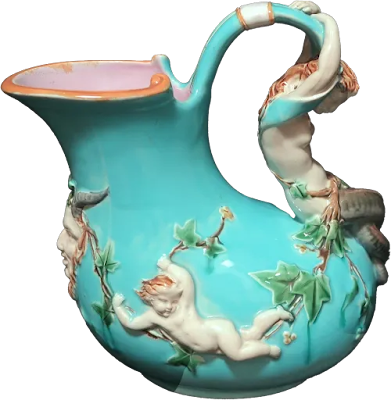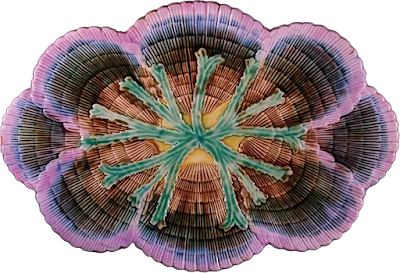MAJOLICA or MAIOLICA ?
It’s very easy to confuse the two words. After all, in English there is only a difference of one letter, but the two pottery wares are very different. To boil it down to the most basic difference, maiolica is decoration applied to a tin oxide base while majolica is colored glaze applied to a lead oxide base. However there is a little bit more to it than that.
History
The different potteries come from a similar idea but from two different technical processes and two different traditions. The name for both derive from Majorca, a major shipping port in the Mediterranean during the 15th century that initially acted as distributor for this early brightly colored ware.
Maiolica: Renaissance maiolica is a pottery of intricate decorative drawing over an opaque tin base. The process originated in Spain and Majorca during the occupation of the Moors in Talavera de la Reina in Toledo in the 14th century but found its greatest success in Italy beginning in the middle of the 15th century, through workshops in Rome, Florence, Naples and Deruta. In time the process also found popularity in northern Europe as Delftware and France as Faience.
After the initial firing of the greenware, the body of the piece is dipped in a vat of tin oxide and allowed to dry. The tin oxide underglaze is a canvas for freehand drawing with colored oxides with various designs by talented painters. The subject varies by origin but is very broad with mythological figures dominating in Renaissance Italy, abstract designs, religious motifs and florals in Moorish Spain and figures and florals in France and the Netherlands
Maiolica, Delft and faience are still in production throughout the world with Italy, Spain, Portugal, Mexico and France the main producers and exporters.
Majolica: The process that gave us Victorian majolica originated from the same roots that formed maiolica but started with a distinctly unique interpretation of the Spanish ware by sculptor Luca della Robbia and his family in 15th century Italy. His use of opaque colored tin glazed terracotta on sculptures and deep reliefs to enhance with color glaze and create a more natural effect proved a sensation in Renaissance Italy and laid the groundwork for the work of potter Bernard Palissy.
Bernard Palissy, working in France during the 16th century, created the basic concept that gave birth to Victorian majolica. It is with him that the two diverge from both a technical and artistic viewpoint.
Instead of opaque tin glaze applied over a tin oxide ground, high lead transparent glazes were applied over a lead oxide base to color sculpturally composed earthenware pottery that imitated nature. Intricately detailed reproductions of plants and animals were laid against a natural ground to create a trompe-l’oeil effect to the delight of 16th century audiences. This he called Rustic Ware.
Three hundred years later, 19th century English art director and ceramicist, Léon Arnoux who was employed by Minton, sought to imitate the work of both Renaissance Italy and Bernard Palissy for his employer. He copied the opaque tin glazes and intricate hand painting of the Italians. Simultaneously his research into Palissy’s Rustic Ware pottery led to the copying of the transparent glazes on a lead oxide base. Although his copies of the tin glazed Italian maiolica proved impractical for long term production at Minton, his imitations of the work of Palissy caught on like wildfire with the public.
Originally called Palissy ware by Minton it was first displayed at the 1851 Crystal Palace Exposition. Eventually its popularity spread to other potteries throughout Europe—Great Britain, France, Germany, Austria, Sweden and Bohemia—as well as Australia, New Zealand, Russia and America under the English name “Majolica.” It remained a popular form for over 60 years before declining in the first quarter of the 20th century. Lead glazed majolica is no longer being made.
It is this Victorian pottery invented by Arnoux, based on Palissy’s work, that is now referred to as majolica and the focus of this blog.
THAT is the difference between majolica and maiolica.



































No comments:
Post a Comment